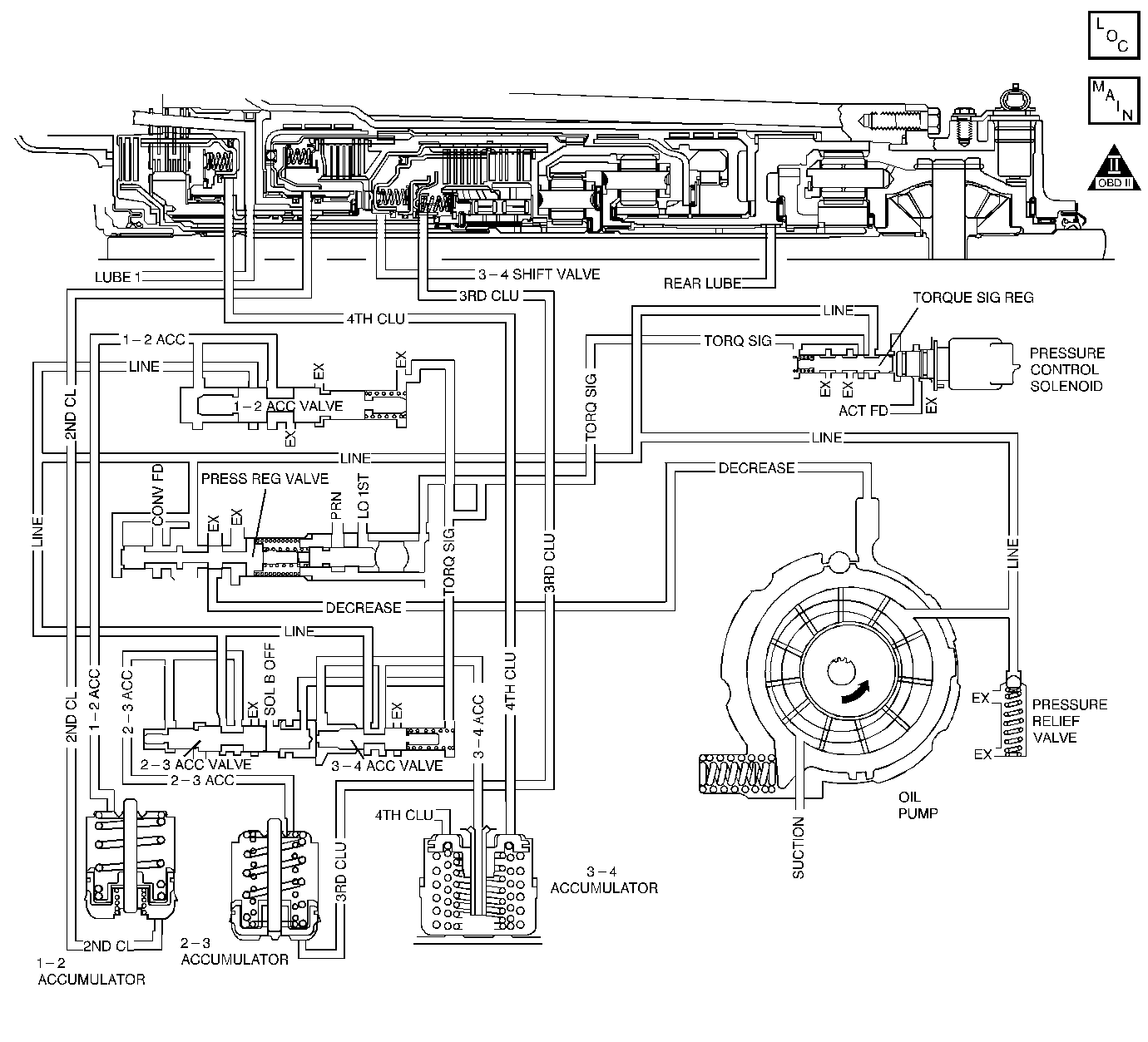
Circuit Description
The transmission pressure is modified by an adaptive modifier which controls the shift execution time. This test checks the time required to accomplish the shift. If the shift takes longer than 0.65 seconds and the adaptive modifier cannot shorten this time, then a counter increases by one.
If the PCM detects the counter reaching two, then DTC P1811 sets. DTC P1811 is a type D DTC.
Conditions for Running the DTC
| • | The shift is adaptable. |
| • | The 1-2, 2-3 or 3-4 shift adapt cell has reached its limit. |
Conditions for Setting the DTC
The 1-2, 2-3 or 3-4 shift is longer than 0.65 seconds, twice in one trip.
Action Taken When the DTC Sets
| • | The PCM does not illuminate the malfunction indicator lamp (MIL). |
| • | The PCM commands maximum line pressure. |
| • | The PCM freezes shift adapts. |
| • | The PCM stores DTC P1811 in PCM history. |
Conditions for Clearing the DTC
| • | A scan tool clears the DTC from PCM history. |
| • | The PCM clears the DTC from PCM history if the vehicle completes 40 consecutive warm-up cycles without a non-emission-related diagnostic fault occurring. |
| • | The PCM cancels the DTC default actions when the fault no longer exists and the ignition switch is OFF long enough in order to power down the PCM. |
Diagnostic Aids
| • | Inspect for possible vehicle overloading, exceeding trailer towing limit or towing in overdrive. |
| • | Ensure that the PCM has the latest calibration update. |
| • | If you performed a transmission overhaul, use the scan tool to clear all adapts. |
Test Description
The numbers below refer to the step numbers on the diagnostic table.
-
This step inspects components located within the valve body, if the fluid pressure gauge readings do not match the commanded PC solenoid valve current to line pressure located in the value column.
-
This step inspects or repairs any of the components listed. A faulty component may lead to a maximum adapt and long shift during a 1-2 upshift.
-
This step inspects or repairs any of the components listed. A faulty component may lead to a maximum adapt and long shift during a 2-3 upshift.
-
This step inspects or repairs any of the components listed. A faulty component may lead to a maximum adapt and long shift during a 3-4 upshift.
Step | Action | Value(s) | Yes | No | ||||||||||||||||||||||
|---|---|---|---|---|---|---|---|---|---|---|---|---|---|---|---|---|---|---|---|---|---|---|---|---|---|---|
1 | Was the Powertrain On-Board Diagnostic (OBD) System Check performed? | -- | Go to Powertrain On Board Diagnostic (OBD) System Check (3.5L) or Powertrain On Board Diagnostic (OBD) System Check (3.8L) in Engine Controls | |||||||||||||||||||||||
2 | Was the transmission fluid checking procedure performed? | -- | Go to Transmission Fluid Check | |||||||||||||||||||||||
3 |
Important: Before clearing the DTCs, use the scan tool in order to record the Failure Records for reference. Using the Clear Info function will erase the stored Failure Records from the PCM. Are any of the following DTCs set: P0120, P0121, P0122, P0123, P1121, P1122, P1524, P0218, P0502, P0503, P0711 or P0712? | -- | ||||||||||||||||||||||||
4 | Diagnose those DTCs first. Is the diagnosis and repair complete? | -- | -- | |||||||||||||||||||||||
5 |
Did all the shift times exceed the specified value? | 0.65 seconds | ||||||||||||||||||||||||
6 | Perform the line pressure check. Refer to the Line Pressure Check . Is the line pressure within specifications? | -- | Go to Diagnostic Aids | |||||||||||||||||||||||
Inspect the transmission for the following conditions:
Refer to Unit Repair. Is the repair complete? | -- | -- | ||||||||||||||||||||||||
8 | Did the 1-2 shift time exceed the specified value? | 0.65 seconds | ||||||||||||||||||||||||
Inspect the transmission for the following conditions:
Refer to Unit Repair. Is the repair complete? | -- | -- | ||||||||||||||||||||||||
10 | Did the 2-3 shift time exceed the specified value? | 0.65 seconds | ||||||||||||||||||||||||
Inspect the transmission for the following conditions:
Refer to Unit Repair. Is the repair complete? | -- | -- | ||||||||||||||||||||||||
12 | Did the 3-4 shift time exceed the specified value? | 0.65 seconds | Go to Diagnostic Aids | |||||||||||||||||||||||
Inspect the transmission for the following conditions:
Refer to Unit Repair. Is the repair complete? | -- | -- | ||||||||||||||||||||||||
14 | Perform the following procedure in order to verify the repair:
Has the test run and passed? | -- | System OK |
